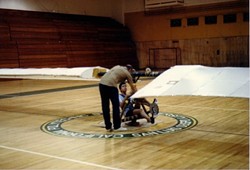Pedaling to new heights
Engineering students at Cal Poly are designing a human-powered helicopter to win a legendary $250,000 prize
By Gene Gisin[{
"name": "Ad - Medium Rectangle CC01 - 300x250",
"id": "AdMediumRectangleCC01300x250",
"class": "inlineCenter",
"insertPoint": "8",
"component": "2963441",
"requiredCountToDisplay": "12"
},{
"name": "Ad - Medium Rectangle LC01 - 300x250",
"id": "AdMediumRectangleCC01300x250",
"class": "inlineCenter",
"insertPoint": "18",
"component": "2963441",
"requiredCountToDisplay": "22"
},{
"name": "Ad - Medium Rectangle LC09 - 300x250",
"id": "AdMediumRectangleLC09300x250",
"class": "inlineCenter",
"insertPoint": "28",
"component": "3252660",
"requiredCountToDisplay": "32"
}]
A group of CalPoly students is constructing a human-powered helicopter to compete for a long-standing $250,000 prize. What this group of students is making is basically a bicycle that hovers. The contraption will compete for the Igor I. Sikorsky Human-Powered Helicopter prize, which was established by the American Helicopter Society in 1980. To win, the helicopter must rise at least 3 meters above the ground, stay in the air for one minute, and remain under control.
Prize competitions have spurred new technologies in many fields; perhaps most prominently in aviation. For example, Charles Lindberg designed and, in 1927, flew the innovative Spirit of St. Louis to complete the first non-stop flight from New York to Paris. His reward was the $25,000 Orteig prize, which was established by a New York hotelier eight years earlier. The prize the CalPoly students aim for has gone unclaimed for 30 years.
Why is the challenge so hard to meet? Power comes only from a human who can be improved by nothing other than exercise and weight loss; the airframe itself is all that can be developed. Hovering is much more difficult to accomplish than flying in a straight line; even that task under human power took a long time to accomplish. The first human-powered flight (actually, a bit more of a hop) occurred in 1936, but an aircraft that could reliably take off and fly under human power was not built until 1961. A 22-mile human-powered flight across the English Channel in competition for the Kremer prize didn’t happen until 1979 when a plane built by another group of Californians, Gossamer Albatross, successfully touched down.
Cal Poly has a distinguished connection to the Sikorsky prize: The university built the first human-powered helicopter that lifted off the ground. That first flight was made in the center of the Mott Gym in 1989 by a machine called Da Vinci III, which was named after Leonardo da Vinci, who conceived of a helicopter in 1493. Da Vinci III was a complicated contraption made of aluminum and polyester film that stayed aloft for 7.1 seconds. A 20-second flight was achieved in 1994 by Yuri I, a helicopter built by a team from a Japanese university.
Though the longest time aloft so far by a human-powered hovercraft is merely a third of that required for the prize, flight height is an even greater issue. Both of the record-setting helicopters to date flew about 8 inches off the ground, nowhere near the height required for the prize. In the new design, the Cal Poly team is planning to save weight by employing fiber-reinforced plastics.
Controlling the helicopter is another difficult problem. It must stay within a 10-by-10-meter square during its minute in the air in order to claim the prize. The full-size prototype under construction will at first will be flown without a pilot onboard. It will be instrumented and monitored during flight attempts, so that the design can be analyzed and improvements be made before the real human-powered attempt at the prize.
The project is an outgrowth of the school-sponsored Aircraft Construction Club, which was created in 2008 to complete construction of a two-seat airplane called the RV-7A, which was accomplished last year. The helicopter is the club’s next challenge. Overall, Da Vinci IV refines the previous helicopter design using modern materials.
About eight students are working on the different components of the helicopter, with each responsible for a particular area of the design. Some are working on the main rotor, on the tip-thruster propellers, on the mechanics and gearing system of the craft, and Professor Kurt Colvin is supervising the design and construction. Another student, as a project for his kinesiology studies, is testing the power output of prospective pilots with a specially-made bicycle rig, and Pete Muller, a machine-shop owner from San Luis Obispo, is volunteering time to advise students on some of the more technical manufacturing issues.
All of the issues present a serious technical challenge, one that wouldn’t be taken up by most aerospace engineering companies unless there were a much higher potential reward. Such collegiate design competitions are a path to new technologies that might otherwise take much longer to develop, and true to Cal Poly tradition, students are learning by doing.
Contact contributing writer Gene Gisin via the editor at [email protected].
Latest in News
Readers also liked…
-

Coast Unified teachers upset over new position's salary and qualifications
Oct 20, 2022 -

SLO police identify alleged driver who hit and killed couple
Dec 22, 2022 -

When the levee breaks: Oceano residents, county officials walk a tightrope of regulations to manage Arroyo Grande Creek, which some say led to the levee's failure in January
May 18, 2023









